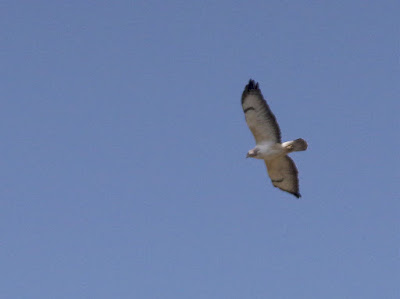I made an early start and took another longish walk to some local grazing marshes. This is interlaced with dykes and has two or three pools, so has the potential to add new species on every visit. Today was no exception, with Grasshopper Warbler (seen briefly but heard well) Swift, Sand Martin, Reed Bunting and Peregrine all new for the list. I also managed to take some photos of Mistle Thrushes and a Cuckoo, which friend Keith pointed out as we chatted (a suitable distance apart, of course!)
My Pentax K-3 is a great piece of kit, but it has a couple of irritating design faults. There is a control button cluster on the rear more or less where you hold the body: just before I photographed the Cuckoo, I must have inadvertently pressed this, so all the subsequent images are in grey scale. This isn't me being 'arty', just an irritating piece of bad luck! The coloured image of the Cuckoo is Keith's!
As well as Keith, I bumped into another local, 'Lingwood' Murray, who had taken some first-class pictures of the Gropper.
Don't forget: you can click on an image to enlarge it!
Thursday, 30 April 2020
Wednesday, 29 April 2020
Plus ça change, plus c'est la même chose.
There's something about extinctions that are still somewhat puzzling: although the causes of three of the largest mass extinction events are now pretty much agreed upon, it's still unclear why some organisms survive - flourish, even - while others vanish. For example, the Mesozoic sea was full of Ammonites and Belemnites: two types of cephalopod molluscs. Their fossils are about the most familiar of all: I'd bet they were the first collected by many of us on our holidays to Dorset. Yet the K-T event that wiped out the dinosaurs, pterosaurs, mosasaurs, ichthyosaurs, plesiosaurs and so on accounted for them too. And yet...
Another family of cephalopods - the nautiluses - managed to survive. Fossil examples from the Cretaceous are pretty much identical to the few modern species.
Another family of cephalopods - the nautiluses - managed to survive. Fossil examples from the Cretaceous are pretty much identical to the few modern species.
Amazing webcams! Lockdown birding made easy!
The NWT has placed cameras at all their flagship reserves (although the Hickling one is currently under repair) This makes it possible to view the scrape at Cley, Ranworth Broad and - best of all - the Stone Curlews at Weeting Heath. As can be seen below, the nesting pair right by the camera have laid two eggs: it'll be exciting to watch these hatch in the fullness of time.
Tuesday, 28 April 2020
White Buzzard: is this the same bird?
Excellent bird artist / birder Mike Lawrence sent me a photo of a very pale Common Buzzard he's seen a few times around his Trimingham home: here's his e-mail
I reckon it's the same bird doing the rounds: as I mentioned to Mike, I bet there'll be a few 'small Eagle' sightings in Norfolk this Spring!
Hello David,
Hope you are
keeping well, noticed on your blog about a Pale Buzzard and wondered if this
photo attached is the same bird? There has been a few pale buzzards passing
through here over the month but none so striking as this bird which has been
touring along here and further up the coast. I photographed this on the 24th
April.
Take care and best
wishes
Mike Lawrence.
I reckon it's the same bird doing the rounds: as I mentioned to Mike, I bet there'll be a few 'small Eagle' sightings in Norfolk this Spring!
 |
| 'My' Buzzard |
 |
| Mike's Buzzard |
Mobbed!
The recently-present very pale Common Buzzard constantly attracts the attention of Crows and Gulls (in this case, a Lesser Black-back) Whenever I hear squawking or mewing, I look from the office window and can virtually guarantee I'll see this striking bird getting 'the good news'! The other local Buzzards don't seem to attract the same level of aggression. Most interesting.
Monday, 27 April 2020
Extended walk...
Since the next few days are predicted to be rainy and cool, I took the opportunity to extend my daily exercise by way of Adam's Wood to a local grazing marsh. Lots of Whitethroats, Blackcaps and Willow Warblers now, as well as Chiffchaffs, Garden Warblers and two Cuckoos on the way.
The longer-than-usual walk did add a few new species: all predictable at this time of year. These included Sedge Warbler, Little Egret, Avocet, Gadwall and Shelduck. I also heard - and saw - half a dozen Cetti's Warblers too. Anyone know what the pretty little moth might be? It was on the kitchen window!
The longer-than-usual walk did add a few new species: all predictable at this time of year. These included Sedge Warbler, Little Egret, Avocet, Gadwall and Shelduck. I also heard - and saw - half a dozen Cetti's Warblers too. Anyone know what the pretty little moth might be? It was on the kitchen window!
The Moon and Venus: snuggling in the western sunset!
The two brightest celestial objects (apart from the Sun!) were at their closest last night: always an impressive sight. They'll be a little further apart tonight, but still worth a look if it's clear.
Sunday, 26 April 2020
Beautiful Buzzard
There's been a gorgeous pale (leucistic?) Common Buzzard hanging around for a week or two: Sue and Peter mentioned it in an e-mail a while back. Today it stooped past as I was mowing the lawn - just time for a couple of pictures...
Possible Honey?
I know the end of April is two weeks too early for Honey Buzzards to be arriving, but this distant bird this morning did look good for the species: long-winged, pigeon-like neck, very flat-winged gliding flight. Perhaps it's just a very pale, beautifully-marked Common, but it really did look 'interesting'!
Subscribe to:
Comments (Atom)




















































